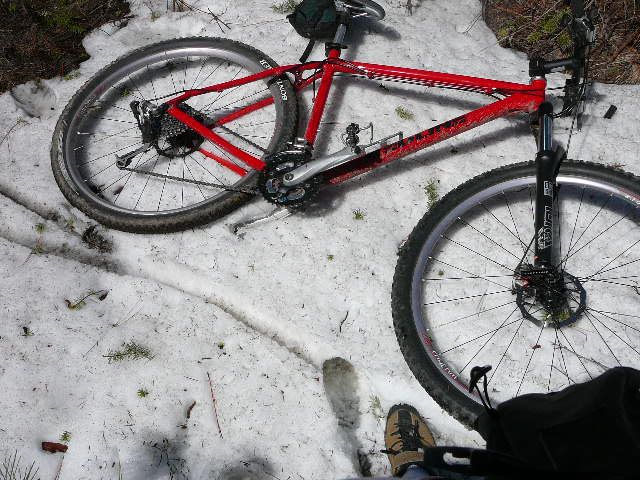I have spent a lot of time winter mountain biking. I first started riding studded tires back in about 1987 or 88. I have studded 27 x1 1/4 and many different 26″ tires. The really skinny tires cut through the snow really well if you have a couple inches and solid ground underneath. We used 1/2 roofing nails from the inside out on our tires at first. Then we used an old inner tube for a liner and thorn tubes.

My Thoughts on bike setup.
Winter riding is very harsh on components so I do not recommend a full suspension. I usually use one of my older mountain bikes because the ice and deicer are really hard on the paint and components. I do recommend a front shocks and a seatpost shock.
Where I ride often there are footprints from hikers that are frozen into the snow. These are often much rougher than most the trails I ride the rest of the year. The suspension seatpost is really helpful at softening the ride.
Ice Falling
The first fall you take riding your bike on the ice will probably be memorable. If you are riding without studs and hit a patch of ice you will fall so fast you will not even realize what is happening. One moment you are riding along and the next you are laying on the ground with a sore elbow and hip. Usually you will not even have time to take your hand off the bars to break your fall.Studded Tires for Winter Bicycle Riding
Normally I ride with a only a studded front tire. The back tire will usually grip fairly well because most of your weight is on it. If the back tire slides around a little bit it is fun, when the front tire slides a little you are normally on the ground. The Front Stud really helps keep me from going down on those random patches of ice.Studded tires add a lot of rolling resistance and are expensive. I have a spare wheel with my studded front tire that I can just swap over. This way if we get warm and lose all the ice I can go back to my regular wheel in less than a minute.
Disc Brakes
Disc brakes are an absolute necessity for winter riding. I rode for years with a studded front tire and rim brakes. If there is any snow around rim brakes do not work at all. The heat from your brakes rubbing on the rims will melt the snow and the water will make your rims slick. Disc brakes rock for winter riding.Staying Dry
I believe it is very important to stay dry. I ride on trails where if I get in trouble there is a good chance there is no one around. I try to have extra dry clothing to put on in case I have to walk out.Clothing
I carry a lot of extra clothing on winter rides. I find that I want to have several ways to adjust my temperature because as the grade changes and the weather changes it take a lot different gear. Most of my riding will include a major climb. I will take a lot of clothing off on the climb to keep my perspiration down.I try to stay dry but I never fully succeed. I want to have warm dry clothing to put on if the weather changes or if I have a major bike issue.
Overall if I can keep my hands, ears and feet warm I will usually have a good ride.
My way of moderating my temperature starts with two pair of gloves (light pair and warm pair) I can also fit the light pair inside the heavy pair for maximum hand warmth, ear muffs, fleece neck warmer, booties, extra long sleeve shirt, Extra long underwear and winter riding pants.
When riding and I start to heat up my first downgrade is to take my warm gloves off and put my light ones on, , then my extra shirt comes off, then my neck warmer comes off, then my coat gets zipped down, and then my booties come off.
My core sweats a lot so I pay close attention to keeping my shirt dry if possible.
No comments:
Post a Comment